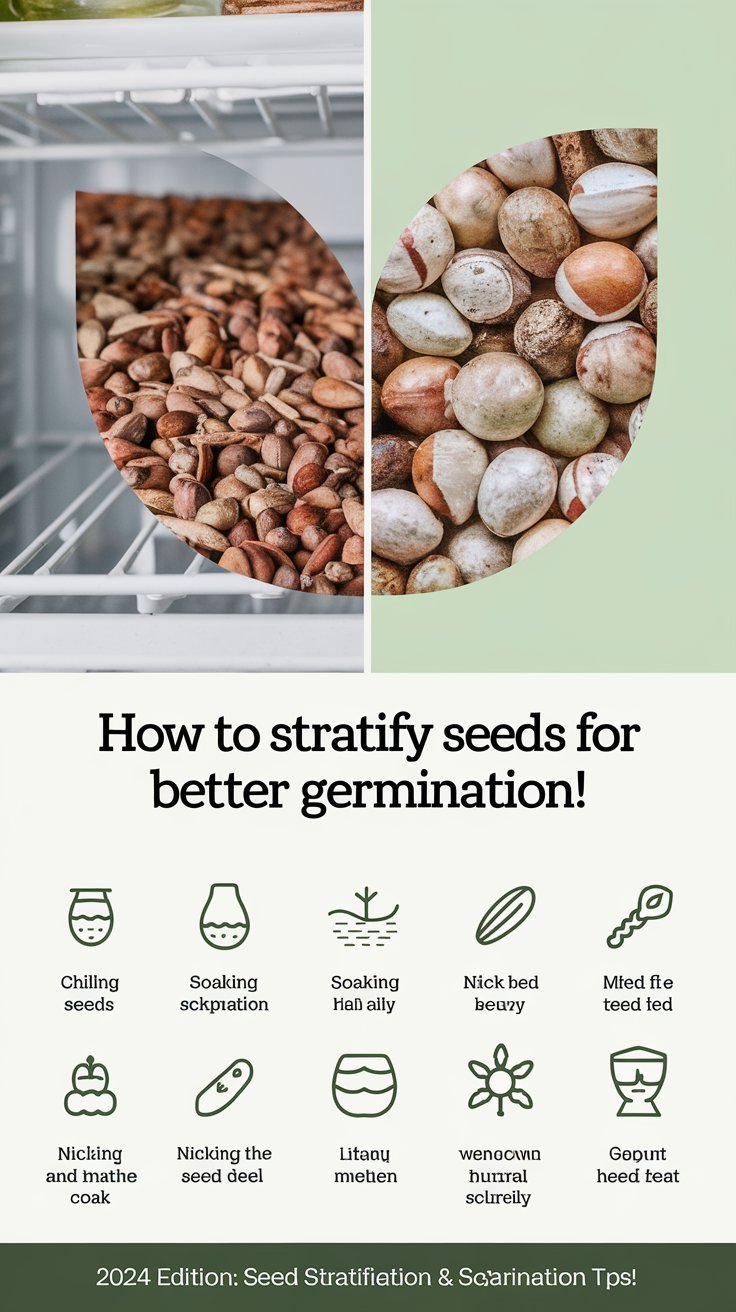Learn how to stratify and scarify seeds to boost germination rates. Expert guide on breaking seed dormancy, with 2024 updates on techniques and trends.
Seeds stratification and scarification are essential techniques for breaking seed dormancy and improving germination rates. These methods mimic natural processes that seeds undergo in the wild, ensuring better success in your gardening endeavors. This guide will walk you through the step-by-step processes of stratification and scarification, providing expert tips and insights for a wide range of seeds.
As a horticulturist with over two decades of experience in plant propagation and seed starting, I’m excited to share my knowledge on these crucial techniques. Let’s dive into the world of seed preparation and unlock the secrets to successful germination!
Understanding Seed Dormancy

Before we delve into stratification and scarification, it’s important to understand seed dormancy:
- Seed dormancy is a natural mechanism that prevents seeds from germinating at the wrong time.
- It ensures species survival by spreading germination over time and space.
- Different seeds have different types of dormancy, requiring specific treatments.
Now, let’s explore the techniques to break this dormancy.
Seed Stratification: Mimicking Winter’s Chill
What is Seed Stratification?
Stratification is the process of exposing seeds to cold and moist conditions to simulate winter weather. This breaks down germination inhibitors in the seed coat.
When to Use Stratification
Use stratification for:
- Seeds from temperate climate plants
- Many tree and shrub seeds
- Perennial flower seeds
2024 Trend: Climate change is altering natural stratification periods, making artificial stratification increasingly important for gardeners and conservationists.
How to Stratify Seeds
- Moisture Method:
- Mix seeds with moist sand or peat moss.
- Place in a plastic bag or container.
- Refrigerate at 32-41°F (0-5°C) for the required period (varies by species).
- Paper Towel Method:
- Wrap seeds in damp paper towels.
- Place in a plastic bag.
- Refrigerate as above.
2024 Innovation: Smart refrigerators with seed stratification settings are emerging for serious gardeners and small-scale nurseries.
Pro Tip: Check seeds weekly for signs of germination or mold. Remove germinated seeds promptly.
Duration of Stratification
Stratification periods vary widely:
- 2-4 weeks for many perennial flowers
- 2-3 months for many tree seeds
- Up to 6 months for some stubborn species
2024 Research: New studies are refining stratification periods for specific cultivars, improving germination rates.
Seed Scarification: Breaking Through Tough Seed Coats
What is Seed Scarification?
Scarification is the process of breaking, scratching, or softening the hard outer coating of seeds to allow water absorption and germination.
When to Use Scarification
Use scarification for:
- Seeds with hard or waxy coats
- Many legume seeds
- Some tree and shrub seeds
2024 Update: Increasing interest in native plants is bringing attention to scarification techniques for wild species.
How to Scarify Seeds
- Mechanical Scarification:
- Use sandpaper to gently abrade the seed coat.
- Nick the seed coat with a knife (be careful not to damage the embryo).
- Hot Water Scarification:
- Pour hot water (just below boiling) over seeds.
- Let them soak as the water cools, typically overnight.
- Acid Scarification (for experienced propagators):
- Soak seeds in concentrated sulfuric acid.
- Rinse thoroughly after treatment.
2024 Innovation: New eco-friendly chemical scarification methods are being developed for commercial use.
Pro Tip: Always wear protective gear when performing acid scarification.
Combining Stratification and Scarification
Some seeds require both treatments:
- Scarify the seeds first.
- Proceed with stratification.
This combination is common for seeds of many wild rose species and certain forest trees.
Best Practices for Seed Treatment
To ensure the best results when stratifying or scarifying seeds:
- Research the specific requirements for each species.
- Maintain consistent moisture and temperature during stratification.
- Use sterile tools and media to prevent mold and disease.
- Keep detailed records of treatments and results.
- Be patient – some seeds may take months to germinate.
Unlocking Nature’s Potential
Mastering seed stratification and scarification opens up a world of possibilities for gardeners and plant enthusiasts. These techniques allow you to grow a wider variety of plants, including rare and native species that might otherwise be challenging to propagate.
Remember, while these methods can significantly improve germination rates, nature still holds some mysteries. Don’t be discouraged if some seeds fail to sprout – each attempt is a learning opportunity.
For more information on seed treatment and plant propagation, visit resources like the Royal Horticultural Society or your local botanical garden. Happy growing, and may your gardens flourish with the fruits of your newfound knowledge!
For more gardening tips and plant care guides, visit usagardenhub.com.



